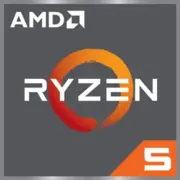AMD Ryzen 5 7600

AMD Ryzen 5 7600: Overview and Practical Recommendations for Building a PC
Balanced Performance for Gaming and Work
1. Key Specifications: Architecture and Key Features
The AMD Ryzen 5 7600 is part of the Zen 4 lineup, released in 2022. It is built on the Raphael architecture and is manufactured using TSMC FinFET 5nm process, which ensures high energy efficiency and transistor density.
Performance:
- 6 cores / 12 threads — optimally suited for gaming and multitasking.
- Base clock speed 3.8 GHz / maximum 5.1 GHz — high speed for single-thread tasks.
- 32 MB L3 cache — reduces latency during memory operations.
- TDP 65 W — low power consumption relative to its performance.
Key Features:
- Integrated Radeon™ Graphics (2 cores, 2200 MHz) — suitable for systems without a discrete graphics card.
- Support for PCIe 5.0 — ready for next-gen SSDs and graphics cards.
- Precision Boost 2 and Adaptive Undervolting technologies — automatic optimization of frequency and voltage.
Practical Example: In Cinebench R23 tests, the processor scores around ~1450 points in single-threaded mode and ~11500 in multi-threaded mode, making it 15-20% faster than the previous Ryzen 5 5600X.
2. Compatible Motherboards: Sockets and Chipsets
The processor uses the AM5 socket, which requires new motherboards. Main chipsets include:
- B650 — the optimal choice for most users: PCIe 5.0 support for graphics cards, 1-2 NVMe Gen5 slots, memory overclocking.
- X670/X670E — for enthusiasts: more USB ports, PCIe 5.0 for SSDs, improved power delivery.
Recommendations:
- A B650 motherboard (e.g., MSI B650 Tomahawk) is sufficient for the Ryzen 5 7600.
- If planning to upgrade to a Ryzen 9 in the future, choose an X670 with 12+2 phase VRM (e.g., ASUS ROG Strix X670E-F).
Important: Update the BIOS before installing the processor — early versions may not support Zen 4.
3. Supported Memory: Transition to DDR5
The Ryzen 5 7600 works only with DDR5, which increases bandwidth but raises the total cost of the build.
RAM Selection Tips:
- Optimal frequency: 5200-6000 MHz (e.g., Kingston Fury Beast DDR5-6000).
- Use dual-channel mode — 2x 16 GB modules instead of one 32 GB module.
- Activate EXPO (AMD's equivalent of XMP) for automatic overclocking.
Pros of DDR5:
- High speeds (up to 6400 MHz).
- Better energy efficiency.
Cons:
- Higher price compared to DDR4.
4. Power Supplies: Power Calculation
With a TDP of 65 W, the Ryzen 5 7600 does not require a powerful PSU, but calculations change when using a discrete graphics card:
- RTX 4070 (200 W) + Ryzen 5 7600: a 650 W PSU is sufficient (e.g., Corsair RM650x).
- RTX 4090 (450 W) + Ryzen 5 7600: at least 850 W is required.
Recommendations:
- Choose units with an 80+ Gold certification or higher.
- Don’t skimp on cables — modular PSUs simplify the build.
5. Pros and Cons of the Processor
Pros:
- High gaming performance (Geekbench 6 Single-Core: 2734).
- Low power consumption.
- Integrated graphics for backup use.
- Support for PCIe 5.0 and DDR5 — future upgrade readiness.
Cons:
- No support for DDR4 — transitioning to new memory is mandatory.
- The stock Wraith Stealth cooler is noisy under load.
- Higher price compared to the Ryzen 5 5600X.
6. Use Cases
Gaming:
- In Full HD (with a card like RTX 3060) — 120+ FPS in Cyberpunk 2077 (without ray tracing).
- In 1440p — stable 60 FPS in AAA titles.
Work Tasks:
- Rendering in Blender: 10% faster than Ryzen 5 5600X.
- Programming: code compilation benefits from 12 threads.
Multimedia:
- Streaming (OBS + gaming) without lag due to 6 cores.
7. Comparison with Competitors
Intel Core i5-13400F:
- Pros: 10 cores (6P+4E), DDR4 support.
- Cons: No integrated graphics, lower IPC.
AMD Ryzen 5 7600X:
- Pros: Boost clock up to 5.3 GHz.
- Cons: TDP of 105 W, pricier.
Conclusion: The Ryzen 5 7600 outperforms Intel in terms of energy efficiency and single-thread performance but falls behind in multi-threaded tasks due to fewer cores.
8. Practical Assembly Tips
- Cooler: Replace the Wraith Stealth with a tower cooler (e.g., DeepCool AK400) for quieter operation.
- Case: Choose models with good ventilation (Mesh front panel, like Lian Li Lancool 216).
- Storage: Use NVMe PCIe 4.0 (e.g., Samsung 980 Pro) for maximum speed.
Mistakes to Avoid:
- Installing DDR4 in the AM5 socket — physically incompatible.
- Using a weak PSU with a top-end graphics card.
9. Final Conclusion: Who Should Consider the Ryzen 5 7600?
This processor is ideal for:
- Gamers who value high FPS and smooth performance.
- Content creators needing moderate multi-thread capabilities.
- Minimalists building a PC without a discrete graphics card.
Why this one?
The Ryzen 5 7600 combines modern technologies (5 nm, DDR5, PCIe 5.0) with a reasonable price. It offers future-proofing and is suitable for those who don’t want to change platforms every two years.
If you are looking for a processor for a "here and now" PC build with upgrade potential — the AMD Ryzen 5 7600 will be an excellent choice.
Basic
CPU Specifications
Memory Specifications
GPU Specifications
Miscellaneous
Benchmarks
Compared to Other CPU
Related CPU Comparisons
Share in social media
Or Link To Us
<a href="https://cputronic.com/cpu/amd-ryzen-5-7600" target="_blank">AMD Ryzen 5 7600</a>

